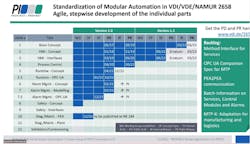Modularization Standards and Adoption Make Strides
Industry reports about the potential benefits of modularization acknowledge that several obstacles remain before chemical plants can implement this strategy. The most common challenges cited are the need for standards in equipment and automation, as well as new business and service models.
However, progress is occurring in these areas.
In Germany, for example, a 2016 white paper on modular plants published by the German Society for Chemical Engineering and Biotechnology (Dechema) laid bare the gaps in skills and knowledge needed for the industry to capitalize on modularization.
One key action to spring from this was the Dechema/ProcessNet working group, which drew together experts from companies such as BASF, Bayer, Clariant and Evonik and several universities to develop and advance ideas.
Michael Heeger, senior engineering manager of technical services within the process engineering unit of BASF’s group research division at Ludwigshafen, Germany, points to two significant developments since the white paper was published.
First, the initially temporary Dechema/ProcessNet working group is now a permanent body.
Secondly, guideline committees have been formed under the umbrella of the Association of German Engineers (VDI). Their efforts are encapsulated in two main guidelines: VDI 2776 (modular plants) and VDI/VDE/NAMUR 2658 (automation engineering of modular systems in the process industry).
“These activities prepared the way for the manufacturer-neutral use of modular approaches by defining the interfaces to enable the components of the modular systems to interact, while leaving the manufacturers sufficient freedom to design their own products individually,” explains Heeger, BASF’s representative on VDI and Dechema modular plant working groups, on the importance of the guidelines.
“The technical control level, which in classic systems is usually executed by a process control system above the equipment level, is shifted to the module level in modular plants. In addition to the procedural components, such as machines and apparatus, and the control hardware, each module is equipped with the required data set to independently carry out the intended process functions,” he adds.
Modularization Challenges and Progress
While some of the design fundamentals are still either in the draft or project stage, the guidelines already contain information on the safety and approval of modular systems, as well as operation and maintenance recommendations.
“This enables a broad manufacturer-neutral use of modular systems and has already led to the launch of the first modular product lines on the market,” says Heeger, noting the guideline committees hold numerous events with industry representatives to exchange experiences and create use cases.
In terms of BASF’s own experiences, the company continues its long-term investigations into the use of customized containers for small-scale, decentralized activities.
“In the future, BASF will check whether modular systems and modular-type packages (MTPs) can be used more in the research environment. A project has just been launched to test such modular approaches and MTP in research facilities for analytic applications, for example,” Heeger says.
On the other hand, he notes that much of the existing infrastructure of chemical companies does not yet allow the broad application of modular concepts because, for example, it is not yet MTP-compatible.
“In addition, modular approaches can generate higher investment costs in the first step compared to stick-built systems,” Heeger explains. “This is due to the more universal design that is used with modules to make them widely useful for future applications. However, this advantage will only be measurable in future applications.”
On a broader scale, Heeger recommends companies considering modular approaches must carefully tailor those approaches to their individual businesses and surroundings. Further, they must plan for the future by considering which modules could be used in subsequent applications.
Another essential is that suppliers have a clear understanding of how the modules will be used, right from the infrastructure planning phase.
Heeger also notes that the type of approvals applied for and received from authorities are crucial. Being able to apply them flexibly, for example, for groups of samples rather than individual ones enables a much wider use of modular approaches.
A New Mindset
Like BASF’s Heeger, ABB is developing and using the VDI/VDE/NAMUR 2658 guideline. In fact, the company already has products to meet the released revisions of parts 1 to 5 of the standard, while it will be implementing parts 7.1 and 10 in the future (Figure 1).
Ralf Jeske, ABB modular automation SME based in Minden, Germany, calls on teams responsible for planning and designing new manufacturing facilities to change their mindset and adopt a new design paradigm that opens new opportunities for the implementation of modular technologies.
“As with other emerging technologies and standards, there’s a Catch-22 situation in which many end users wait for a technology demonstration or maturity in their respective industries but then delay starting to pilot to assess benefits,” he says. “It’s a risk-averse behavior, which delays the experimentation and the learning associated with the pilot/experiment. Once the first references are built, the concept has the potential to become mainstream, and the early adopters have already addressed learning curves, minimized risk and validated the areas in which they’ll gain competitive advantage.”.
It's also about learning. For example, ABB’s carried out its first modularization pilot project with Bayer in late 2018 and helped the company increase automation efficiency and production flexibility. “ABB learned that modular automation is a continuous process that needs to adapt to upcoming new versions and enhancements,” adds Haller.
Do the Economics Stack Up?
It’s a point considered in detail in “Decentralized modular production to increase supply chain efficiency in chemical markets: an example of polymer production,” a 2021 paper published in the Journal of Business Economics.
Using data supplied by a polymer manufacturer whose identity remains confidential, the authors demonstrated important synergies between modular production concepts and local sourcing and that it is crucial to select an appropriate technical design for the modular production system.
To do this, they used a mathematical formulation to optimize modular production networks in the specialty chemical industry. The model uses a new type of constraint for modeling relocations, allowing it to be optimally solved for several scenarios.
The results show that if local sourcing is used, it is often possible to reduce the distance to both suppliers and customers by the appropriate placement of the production facilities.
An autonomous operation of the production facilities and flexible processes also substantially reduced the delivery distance and the production network cost. As a result, shorter delivery distances can also improve the carbon dioxide balance of the production network.
The paper notes that these two options for the technical design can reduce the operational costs for each production facility or the costs for the modular plants in use.
“If the production of base polymers is part of the core business of a company, local sourcing options may not be viable because they are associated with the loss of the profit margin for base polymers,” the authors note. “However, our case study has shown that both autonomous production facilities and flexible production processes can already lead to a more efficient production network.”
According to co-author Tristan Becker, chair of operations management, school of business and economics, at RWTH Aachen University, Germany, the model can be applied to other processes, particularly those at the end of the value chain.
“Here, modular production concepts allow for product customization to demand and can also support postponement strategies,” he explains. “Furthermore, high demand uncertainties or a large volatility favor the application of modular production concepts, since the flexibility allows for an efficient response to these types of customer demands.”
So, for example, Becker believes the model could be applied to the decentralized modular production of medicines and vaccines, enabling a swift response to demand and reducing the complexities of transportation in the supply chain.
He also points to potential uses for crop-protection product manufacturing, which experiences short-term demand for specific products and must contend with spoilage issues.
“Our models might need to be adapted for an application to a specific case, but the general idea remains valid,” he adds.
The paper suggests that future research could apply the proposed mathematical formulation to determine the suitable capacity module sizes for engineering, enabling the design of modular plants based on market demand requirements. It also could be used to evaluate the financial impact of collaborations between companies associated with modular production networks.
“We are seeing companies which use modular production facilities in certain cases and expect the adoption to grow,” Becker says. “However, the collaboration between companies is still limited and needs to be enhanced. From a research perspective, we are observing a rapid growth of the literature on optimization methods for planning issues that arise in modular production networks.”
The Future of Modularization
Article co-author professor Stefan Lier of the department of logistics and supply chain management in the faculty of engineering and economics at the South Westphalia University of Applied Sciences, Meschede, Germany, highlights other potential advantages and challenges of modularization.
For example, standardized modules help with improved project budgeting and timelines. “On the other hand, their fit to a particular case may not be 100%, lowering the potential cost efficiencies,” he says.
So Lier believes that manufacturers of modular systems will have to work more closely with each other to achieve optimum equipment standardization, while at the same time working to meet specific user demands.
He adds that MTP technology is helping address the automation challenges of modularization while enhancing supply chain management with flexibility in capacities, product variety and location as well as increased resilience.
Both Becker and Lier note that for broader applicability, new concepts for small-scale apparatuses are required for a wide range of process steps.
For instance, they have assumed long-term leasing contracts for facilities in the case studies. Flexible short-term leasing contracts could additionally promote the locational flexibility of modular plants. Furthermore, different companies could be responsible for the construction of modular plants and operation of a modular production network, opening up the possibility for new business models.
Commenting on the research in the paper, BASF’s Heeger notes that the benefit of modular approaches competes with the economy of scale of large-volume systems and the BASF Verbund model.
“Modular plants will not play a major role for products manufactured in large quantities in an existing plant network,” he says. “Nevertheless, I am convinced that there will also be applications at BASF where modular systems offer added value. In addition to research facilities, this can include production facilities for products with medium to small volumes for local or strongly fluctuating markets.”
Heeger adds that this can also result in interesting approaches for new business models within the company and with external cooperation partners.
“Here, for example, an in-house pooling of MTP-enabled modules, which are supplemented with modules from the external market on a purchase or leasing basis, is conceivable,” he shares. “Especially in times of great financial pressure, leasing models are an option to reduce investment hurdles. The future will show if the market offers such options on a larger scale, but the possibility for the manufacturer-neutral description is given by the modular approach.”
About the Author
Seán Ottewell
Editor-at-Large
Seán Crevan Ottewell is Chemical Processing's Editor-at-Large. Seán earned his bachelor's of science degree in biochemistry at the University of Warwick and his master's in radiation biochemistry at the University of London. He served as Science Officer with the UK Department of Environment’s Chernobyl Monitoring Unit’s Food Science Radiation Unit, London. His editorial background includes assistant editor, news editor and then editor of The Chemical Engineer, the Institution of Chemical Engineers’ twice monthly technical journal. Prior to joining Chemical Processing in 2012 he was editor of European Chemical Engineer, European Process Engineer, International Power Engineer, and European Laboratory Scientist, with Setform Limited, London.
He is based in East Mayo, Republic of Ireland, where he and his wife Suzi (a maths, biology and chemistry teacher) host guests from all over the world at their holiday cottage in East Mayo.


